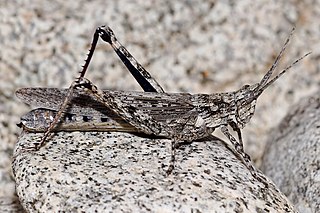
Locusts are certain species of short-horned grasshoppers in the family Acrididae that have a swarming phase. These insects are usually solitary, but under certain circumstances they become more abundant and change their behaviour and habits, becoming gregarious. No taxonomic distinction is made between locust and grasshopper species; the basis for the definition is whether a species forms swarms under intermittently suitable conditions. These grasshoppers are innocuous, their numbers are low, and they do not pose a major economic threat to agriculture. However, under suitable conditions of drought followed by rapid vegetation growth, serotonin in their brains triggers a dramatic set of changes: they start to breed abundantly, becoming gregarious and nomadic when their populations become dense enough. They form bands of wingless nymphs which later become swarms of winged adults. Both the bands and the swarms move around and rapidly strip fields and cause damage to crops. The adults are powerful fliers; they can travel great distances, consuming most of the green vegetation wherever the swarm settles.

Schistocerca nitens is a species of grasshopper known by several names, including vagrant grasshopper and gray bird grasshopper. It is a close relative of the desert locust, which is in the same genus. This grasshopper is native to southern North America including Mexico and the southwestern United States from California to Texas. Can also be found in parts of mid atlantic states. Recently found on Long Island New York. It is also present in parts of Central America. It lives in many habitats including desert, woodland, and lower elevation mountainous areas. It is a large grasshopper, reaching lengths of 4 to 7 centimeters. It is mostly brown and gray spotted or patched in cryptic coloration. This species is known as a pest on ornamental plants and many types of crop plants.
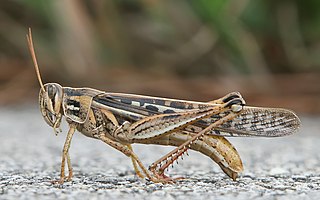
Schistocerca is a genus of grasshoppers, commonly called bird grasshoppers, many of which swarm as locusts. The best known species is probably the desert locust. Around 50 other species are described.

Metarhizium acridum is the new name given to a group of fungal isolates that are known to be virulent and specific to the Acrididea. Previously, this species has had variety status in Metarhizium anisopliae ; before that, reference had been made to M. flavoviride or Metarhizium sp. describing an "apparently homologous and distinctive group" of isolates that were most virulent against Schistocerca gregaria in early screening bioassays.
Schistocerca camerata is a grasshopper species in the genus Schistocerca.

Schistocerca americana is a species of grasshopper in the family Acrididae known commonly as the American grasshopper and American bird grasshopper. It is native to North America, where it occurs in the eastern United States, Mexico, and the Bahamas. Occasional, localized outbreaks of this grasshopper occur, and it is often referred to as a locust, though it lacks the true swarming form of its congener, the desert locust.
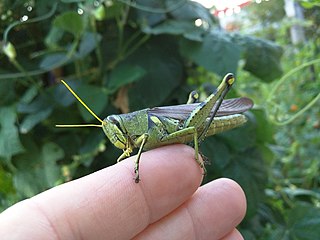
Schistocerca alutacea, the leather-colored bird grasshopper, is a species of grasshopper in the family Acrididae. The species occurs in the United States, from Massachusetts to Arizona and Florida.

The Cyrtacanthacridinae are a subfamily of Orthoptera: Caelifera in the family Acrididae. They are sometimes referred-to as bird locusts, criquets voyageurs in French-speaking Africa, and Knarrschrecken in German.
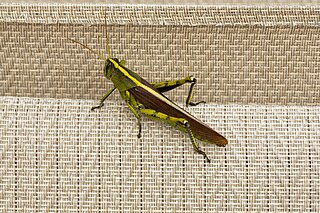
Schistocerca obscura, the obscure bird grasshopper, is a species of grasshopper in the family Acrididae. The species occurs in the United States, from Maryland south to Florida and west to Arizona.
Schistocerca ceratiola, the rosemary grasshopper, is a species of bird grasshopper in the family Acrididae. It is found in North America.
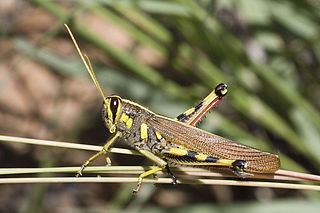
Schistocerca albolineata, the white-lined bird grasshopper, is a species of bird grasshopper in the family Acrididae. It is found in North America, often near the U.S.-Mexico border.

Schistocerca rubiginosa, the rusty bird grasshopper, is a species of bird grasshopper in the family Acrididae. It is found in North America and South America.
Chlorochroa lineata is a species of stink bug in the family Pentatomidae. It is found in North America.

Schistocerca shoshone, known generally as the green bird grasshopper or green valley grasshopper, is a species of bird grasshopper in the family Acrididae. It is found in North America.
Sigara lineata is a species of water boatman in the family Corixidae. It is found in North America.
Eritettix is a genus of slant-faced grasshoppers in the family Acrididae. There are at least four described species in Eritettix.
Hydrochara lineata is a species of water scavenger beetle in the family Hydrophilidae. It is found in Central America and North America.
Montezumina is a genus of phaneropterine katydids in the family Tettigoniidae. There are at least 30 described species in Montezumina.

Schistocerca damnifica, known generally as the mischievous bird grasshopper or Carolina locust, is a species of bird grasshopper in the family Acrididae. It is found in North America.

